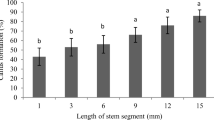Summary
Dogwood anthracnose, caused by the fungus Discula destructiva Redlin, is a severe disease of flowering dogwood (Cornus florida L.) and Pacific dogwood (C. nuttallii Aud.). Disease control is inadequate in nurseries and landscapes and absent in the forest, and resistant cultivars are not commercially available. The ability to select tissues insensitive to culture filtrates from D. destructiva in vitro offers a novel and important approach for the selection of dogwood genotypes that are resistant to or tolerant of this devastating fungus. Embryo-derived dogwood callus cultures were established on Murashige and Skoog medium amended with benzyladenine (BA) and either 2,4-dichlorophenoxyacetic acid (2,4-D) or naphthaleneacetic acid (NAA). Selection for insensitivity to D. destructiva metabolites was done by placement of individual cultures on media amended with progressively higher concentrations of a partially purified culture filtrate (PPCF) containing lowmolecular-weight compounds. Following this selection process, cultures were challenged in a dose-response format with PPCF to determine whether the sensitivity of the callus to the culture filtrate had changed. During the selection period, the fresh weight of callus grown on medium containing 2,4-D and amended with PPCF was always less than that of callus grown on medium amended with the same concentration of potato-dextrose broth (PDB, negative control). Fresh weight of callus was greater on medium containing NAA amended with PPCF than on medium with the same concentration of PDB. Callus selected in the presence of NAA showed decreased sensitivity to toxic metabolites at higher concentrations of culture filtrate. The in vitro system described may assist in the identification of disease-resistant germplasm important to the long-term survival of flowering dogwood.
Similar content being viewed by others
References
Arcioni, S.; Pezzotti, M.; Damiani, F. In vitro selection of alfalfa plants resistant to Fusarium oxysporum f. sp. medicaginis. Theor. Appl. Genet. 74:700–705; 1987.
Buiatti, M.; Ingram, D. S. Phytotoxins as tools in breeding and selection of disease-resistant plants. Experientia 47:811–819; 1991.
Daub, M. E. Tissue culture and the selection of resistance to pathogens. Ann. Rev. Phytopathol. 24:159–186; 1986.
Daughtrey, M. L.; Hibben, C. R. Lower branch dieback, a new disease of northeastern dogwoods. (abs.) Phytopathology 73:365; 1983.
Engvild, K. C. Substituted indoleacetic acids tested in tissue cultures. Physiol. Plant. 44:345; 1978.
Gengenbach, B. G.; Rines, H. W. Use of phytotoxins in selection of disease resistant mutants in tissue culture. Iowa State J. Res. 60:449–476; 1986.
Gentile, A.; Continella, G.; Vardi, A. Differential responses of citrus calli and protoplasts to culture filtrate and toxin of Phoma tracheiphila. Theor. Appl. Genet. 83:759–764; 1992.
Hammerschlag, F. A. Selection of peach cells for insensitivity to culture filtrates of Xanthomonas campestris pv. pruni and regeneration of resistant plants. Theor. Appl. Genet. 76:865–869; 1988.
Hartman, C. L.; McCoy, T. J.; Knous, T. R. Selection of alfalfa (Medicago sativa) cell lines and regeneration of plants resistant to the toxin(s) produced by Fusarium oxysporum f. sp. medicaginis. Plant Sci. Lett. 34:183–194; 1984.
Lamari, L.; Ballance, G. M.; Orolaza, N. P., et al. In planta production and antibody neutralization of the Ptr necrosis toxin from Pyrenophora tritici-repentis. Phytopathology 85:333–338; 1995.
McElreath, S. D.; Tainter, F. H. A sporulation medium for Discula destructiva, the dogwood anthracnose fungus. Curr. Microbiol. 26:117–121; 1993.
Meredith, C. P.; Carlson, P. S. Herbicide resistance in plant cell cultures. In: LeBaron, H. M.; Gressel, J., ed. Herbicide resistance in plants. New York: John Wiley and Sons; 1982:275–292.
Murashige, T.; Skoog, F. A revised medium for rapid growth and bioassays with tobacco tissue culture. Physiol. Plant. 15:473–497; 1962.
Okuda, T.; Yoshida, T.; Hatano, T. Pharmacologically active tannins isolated from medicinal plants. In: Hemingway, R. W.; Laks, P. E., ed. Plant polyphenols. New York and London: Plenum Press; 1992:539–569.
Rines, H. W.; Luke, H. H. Selection and regeneration of toxin-insensitive plants from tissue cultures of oats (Avena sativa) susceptible to Helminthosporium victoriae. Theor. Appl. Genet. 71:16–21; 1985.
Thanutong, P.; Furusawa, I.; Yamamoto, M. Resistant tobacco plants from protoplast-derived callus selected for their resistance to Pseudomonas and Alternaria toxins. Theor. Appl. Genet. 66:209–215; 1983.
Trigiano, R. N.; Beaty, R. M.; Dietrich, J. T. Somatic embryogenesis and plantlet regeneration in Cornus florida. Plant Cell Rep. 8:270–273; 1989.
Vardi, A.; Epstein, E.; Breiman, A. Is the Phytophthora citrophthora culture filtrate a reliable tool for the in vitro selection of resistant Citrus variants? Theor. Appl. Genet. 72:569–574; 1986.
Venkatasubbaiah, P.; Chilton, W. S. Toxins produced by the dogwood anthracnose fungus Discula sp. J. Nat. Prod. 54:1293–1297; 1991.
Walkinshaw, C. H.; Anderson, R. L. Histology of Cornus florida L. leaves infected naturally and artificially by Discula sp. USDA For. Serv. Res. Note SE-360. 1991:4 pp.
Wedge, D. E. Phytotoxins of Discula destructiva: detection, isolation and use in a tissue culture system to assess in vitro selection of Cornus florida. Ph.D. Dissertation. Clemson University. Clemson SC. 1995:120 pp.
Wedge, D. E.; Baird, W. V.; Tainter, F. H. An in vitro detection system for Cornus florida calli resistant to toxic metabolites of Discula destructiva. (abs.) In Vitro Cell. Dev. Biol. 31:55; 1995b.
Wedge, D. E.; McElreath, S. D.; Tainter, F. H. A bioassay for studying toxic metabolites of Discula destructiva. (abs.) Phytopathology 83:1393; 1993a.
Wedge, D. E.; McElreath, S. D.; Tainter, F. H. Bioassay of toxic metabolites of fungi associated with dogwood anthracnose. Proc. Southern Nurserymen’s Assoc. Res. Conf. 38:43–45; 1993b.
Wedge, D. E.; Tainter, F. H.; Camper, N. D. Establishment of a tissue culture protocol for pharmacologically important Cornaceae. In: Gustine, D. L.; Flores, H. E., ed. Phytochemicals and health. Curr. Topics Plant Physiol.: Amer. Soc. Plant Physiol. Ser. 15; 1995a.
Author information
Authors and Affiliations
Rights and permissions
About this article
Cite this article
Wedge, D.E., Tainter, F.H. In vitro detection of Cornus florida callus insensitive to toxic metabolites of Discula destructiva . In Vitro Cell.Dev.Biol.-Plant 33, 142–146 (1997). https://doi.org/10.1007/s11627-997-0013-y
Received:
Accepted:
Issue Date:
DOI: https://doi.org/10.1007/s11627-997-0013-y




